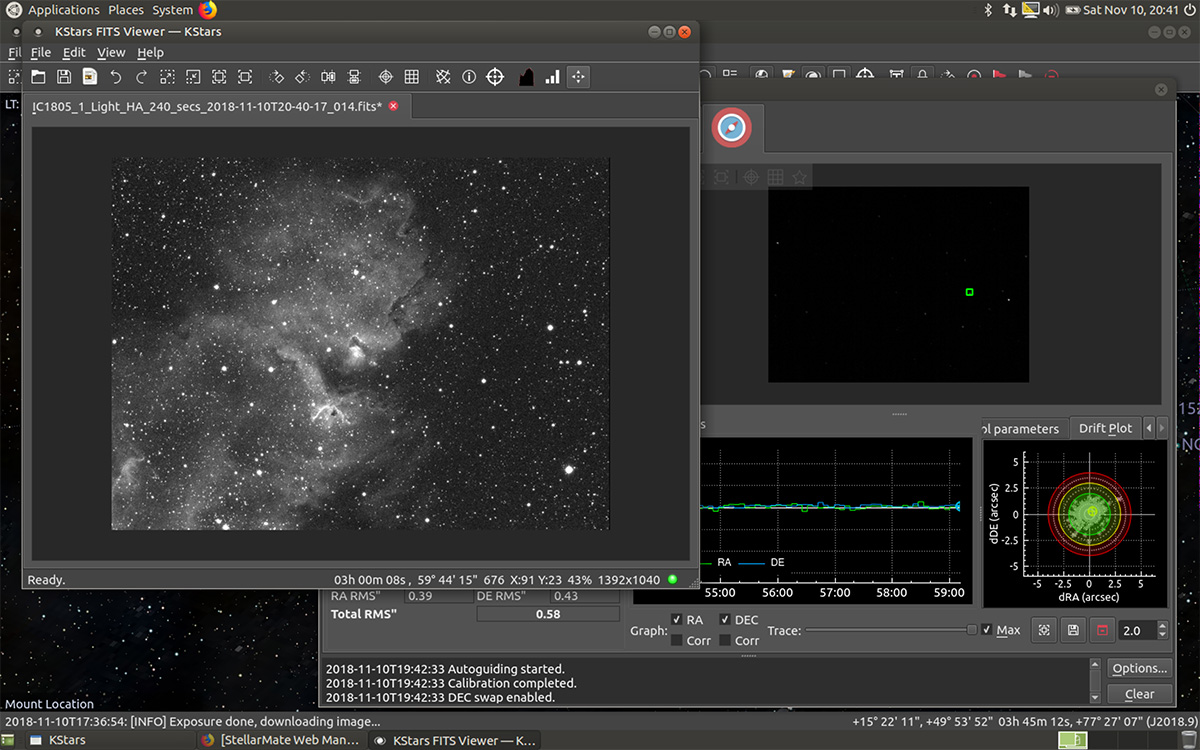California Nebula - NGC 1499 Bi-color Ha + SII
NGC 1499, California Nebula in bi-color narrowband hydrogen-alpha and sulfur 2. I captured this data on the 25th, but didn't have time to capture oxygen 3 frames with high clouds moving in and the moon rising. Even so, I like the way this turned out with the two bandpasses, almost fluorescent. NGC 1499 is about 1000 lightyears away, and if you haven't guessed, it's called "California Nebula" because if you flip this image 90 degrees counterclockwise it looks like the state.
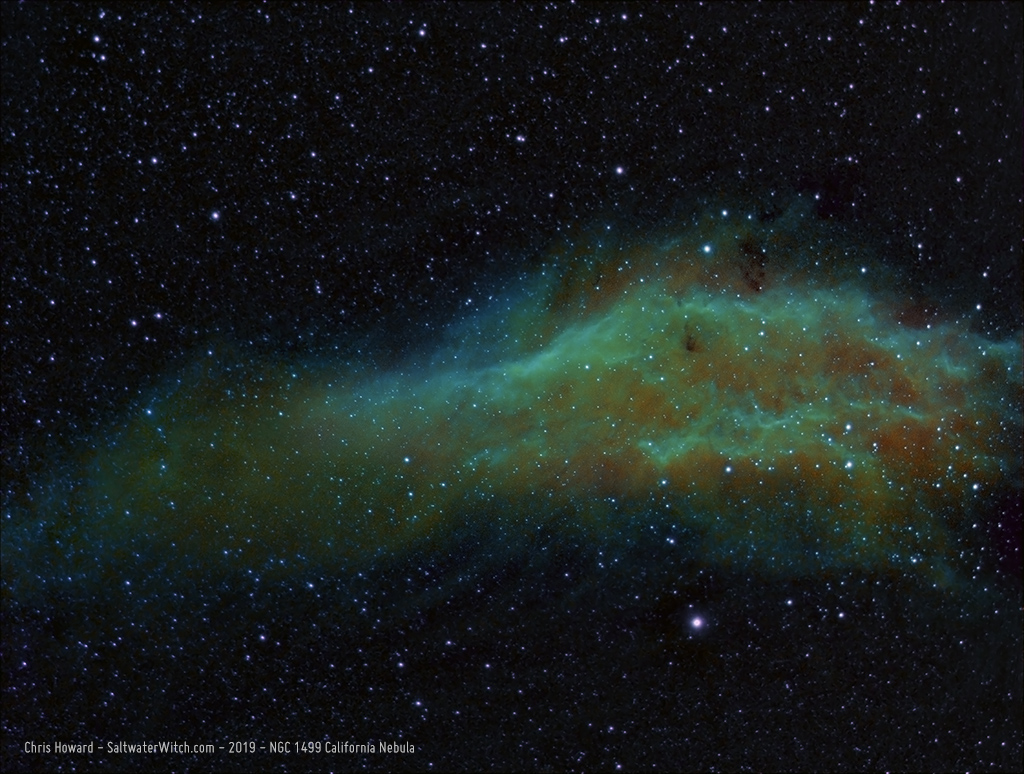
Posted December 28, 2018
IC 1805 - Heart Nebula in the Hubble Palette
The clouds and icy rain are here, and I've had time to process some of the data I captured over the last two nights. Here's IC 1805 and neighboring nebulae and star clusters in hydrogen-alpha, oxygen 3, sulfur 2 using the Hubble palette (SHO mapped to RGB). The Heart swings around the north celestial pole below the "W" asterism of Cassiopeia, and with trees to the north and the house blocking the view west I don't have all night to capture data. So, I went with the 11 x 300 seconds of Ha, 21 x 300 seconds of OIII, and 13 x 300 seconds of SII. Equipment: William Optics ZS61 APO refractor, ZWO ASI1600MM-Pro monochrome camera (unity gain 139/21), Astronomik filters, iOptron CEM25P mount, INDI/Ekos/KStars running in Stellarmate/Raspberry Pi 3b+.
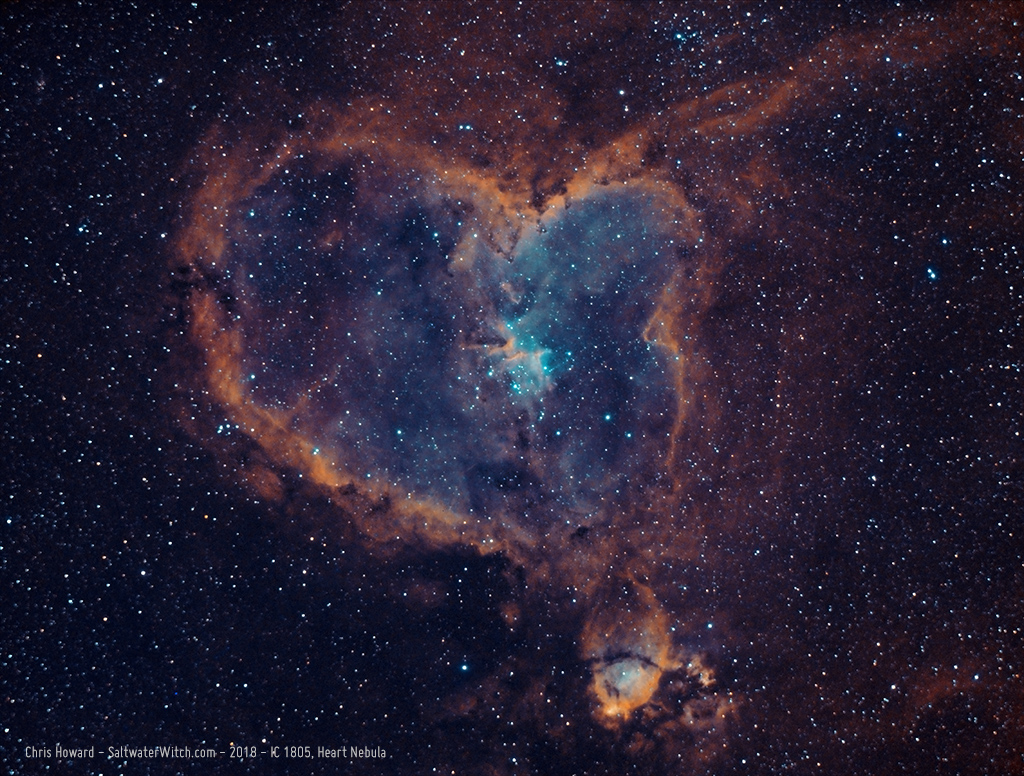
Posted December 28, 2018
Astro Session with the new ZWO ASI1600MM-Pro
Wide-field of M42, the Orion Nebula--and it's amazing how cloudy and dusty the whole area is. I spent half the night adjusting things--focus distance, off-axis guider spacing, but managed to capture M42 and the surrounding region (two sets of subs: 21 x 300 second, and 20 x 20 second for the bright Nebula core and Trapezium). Calibration frames: 20 Dark and 20 Bias, No flat frames. I shot these with the ZWO ASI1600MM-Pro monochrome camera, Astronomik 12nm Ha filter, William Optics ZS61 APO, iOptron CEM25P mount.
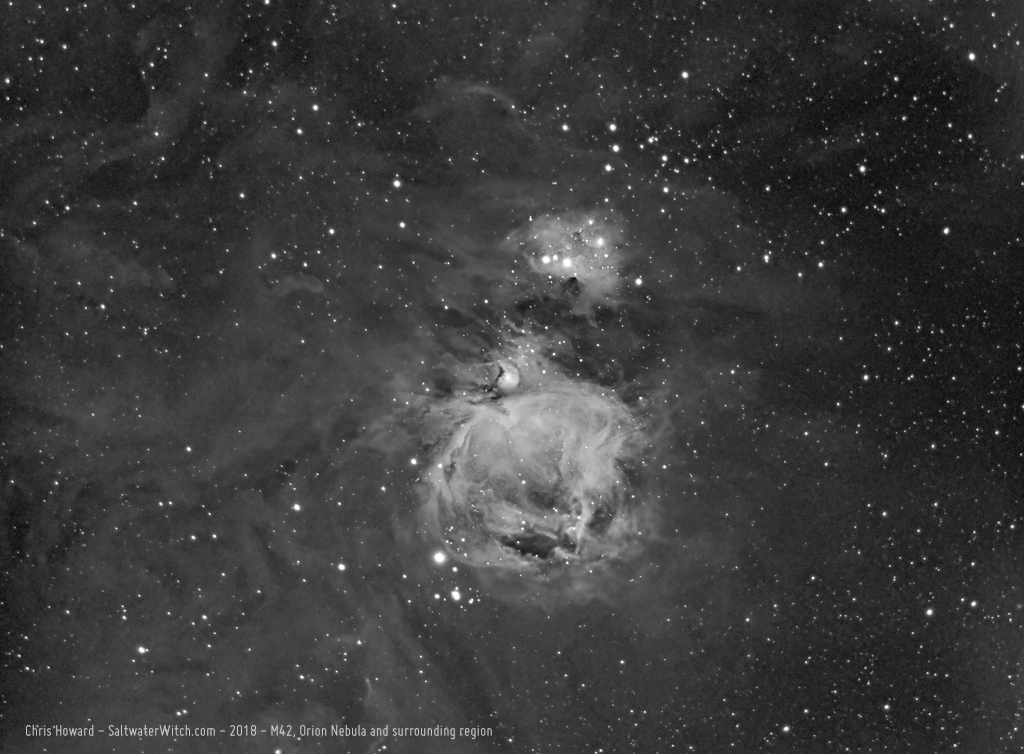
I also managed to capture a dozen frames of the California Nebula:
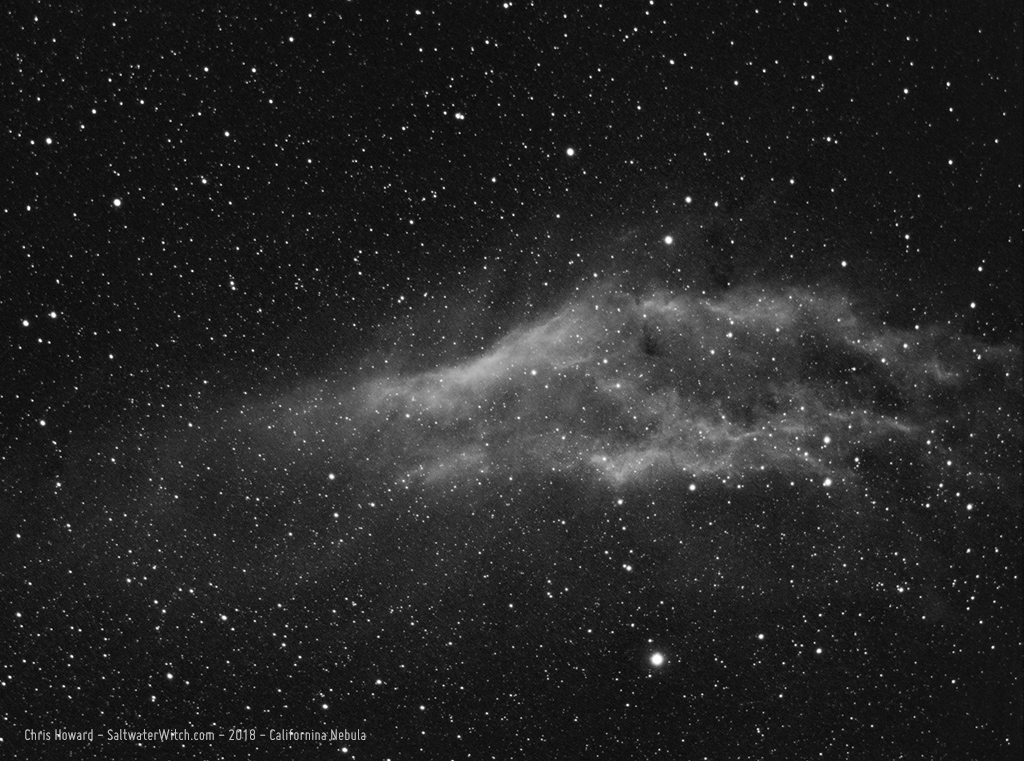
Posted December 26, 2018
Heart Nebula with the ZWO ASI071MC Color CMOS Camera
This one of the Heart Nebula (IC 1805) in Cassiopeia is comprised of 27 x 600 second exposures, taken over several nights, with the ZWO ASI071MC and the William Optics GT81 APO refractor, no filters, no calibration frames, stacked in DSS, processed in PSCC 2019. This is pretty impressive for a color camera when you consider the Heart is mostly made up of glowing ionized hydrogen gas and dust (perfect for narrowband imaging), and it's a relatively dim object--with the exception of NGC 896, the bright "Fish Head Nebula" at the bottom.
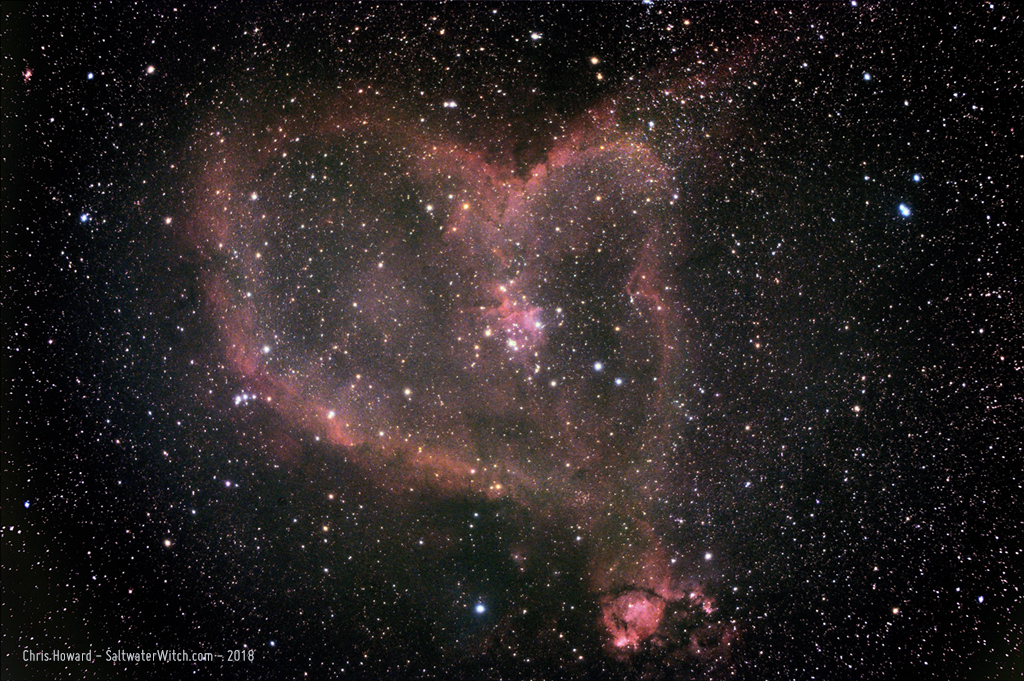
Posted December 13, 2018
Orion Mosaic
I've had the Orion Atlas EQ-G, William Optics GT81, and ZWO ASI071MC camera set up for the last three days. It's been cold--down around -10C in the early morning hours. With a new moon that's slowly waxing, but still mostly absent from the night sky, I've been using the color camera to capture some amazing targets, including this three panel mosaic of the Orion Nebula (M42), Running Man Nebula, Horsehead Nebula (Barnard 33), Flame Nebula (NGC 2024), and the three giant stars in Orion's Belt, Alnitak, Alnilam, and Mintaka. This is why the Orion Constellation is arguably the sky's most impressive constellation. NOTES: 31 x 300 second exposures for each, with an additional set of 10 and 30 second exposures for the Trapezium in M42--that really bright triangular region. There's just so much fiery star forming action at the heart of the Orion Nebula that any exposure over a dozen seconds is going to blow out the whole area.
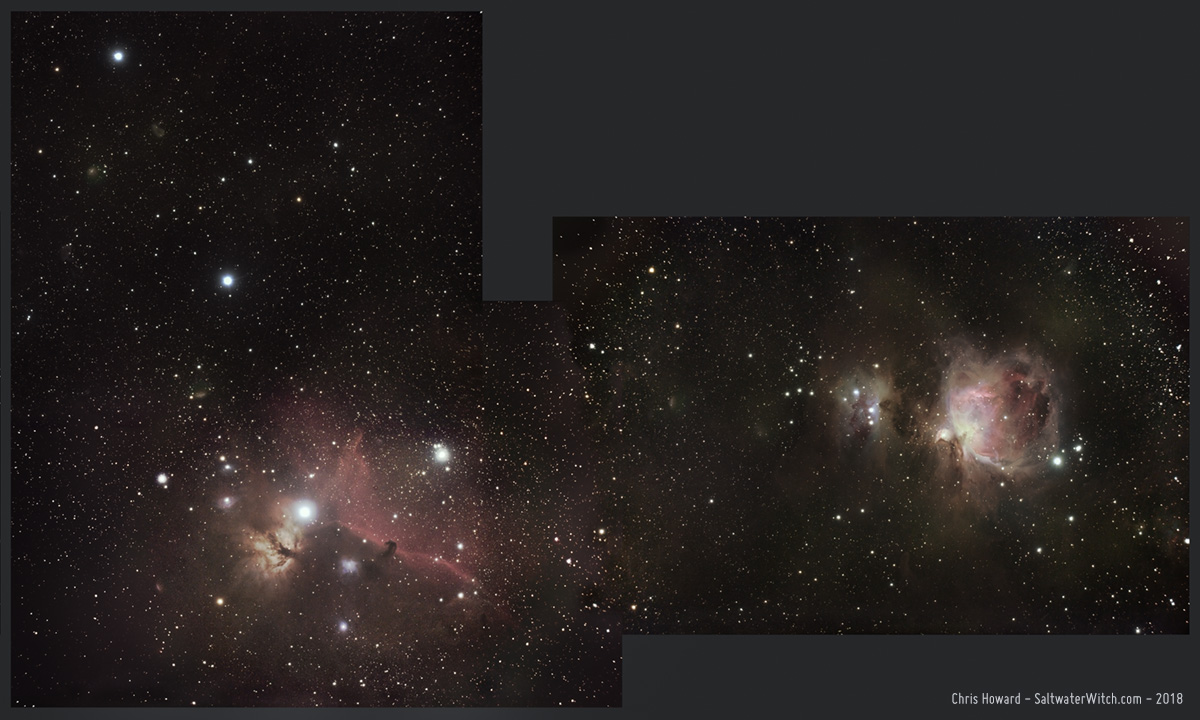
Here's my setup for the last few nights:
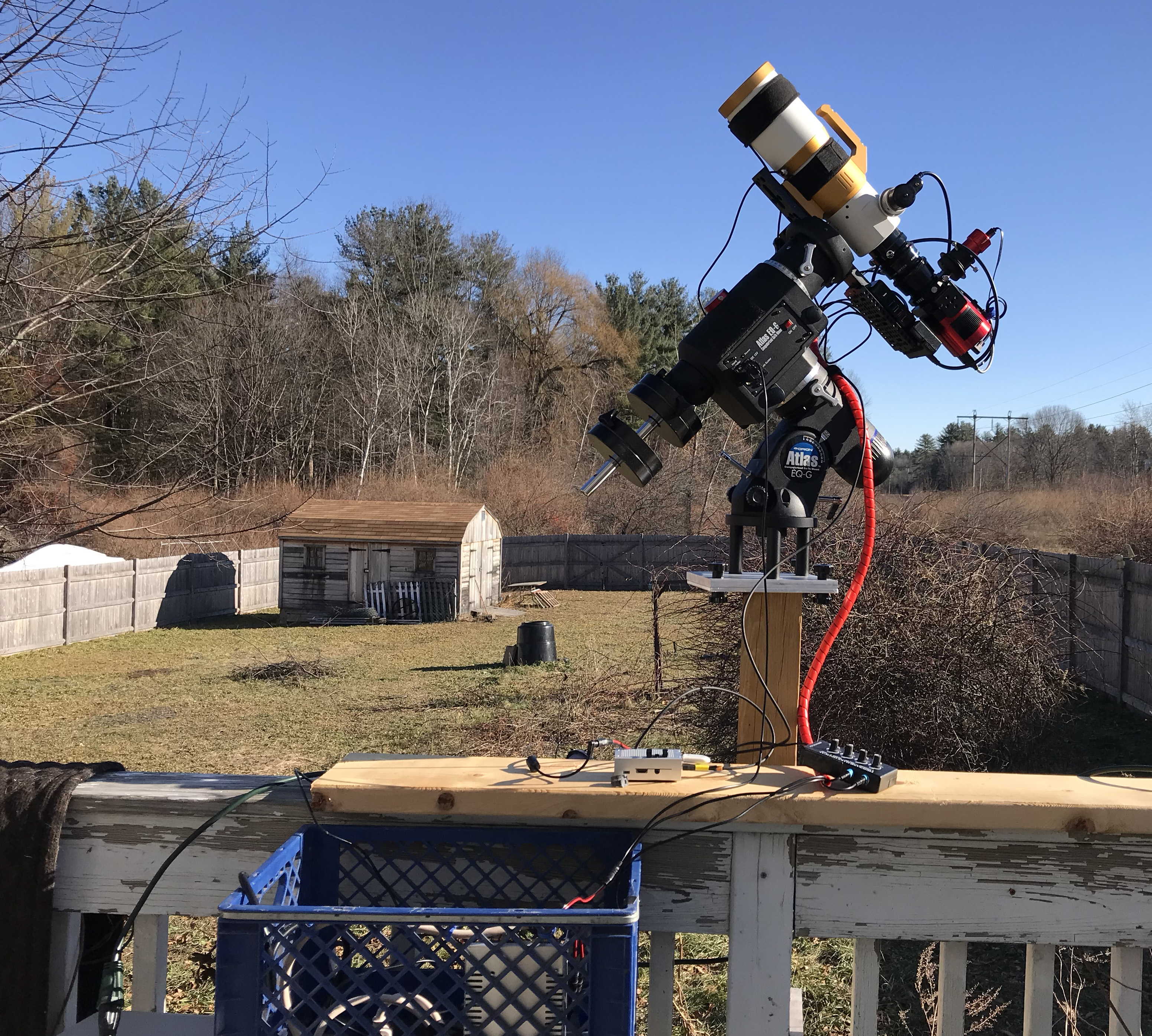
Orion at the southern Meridian:
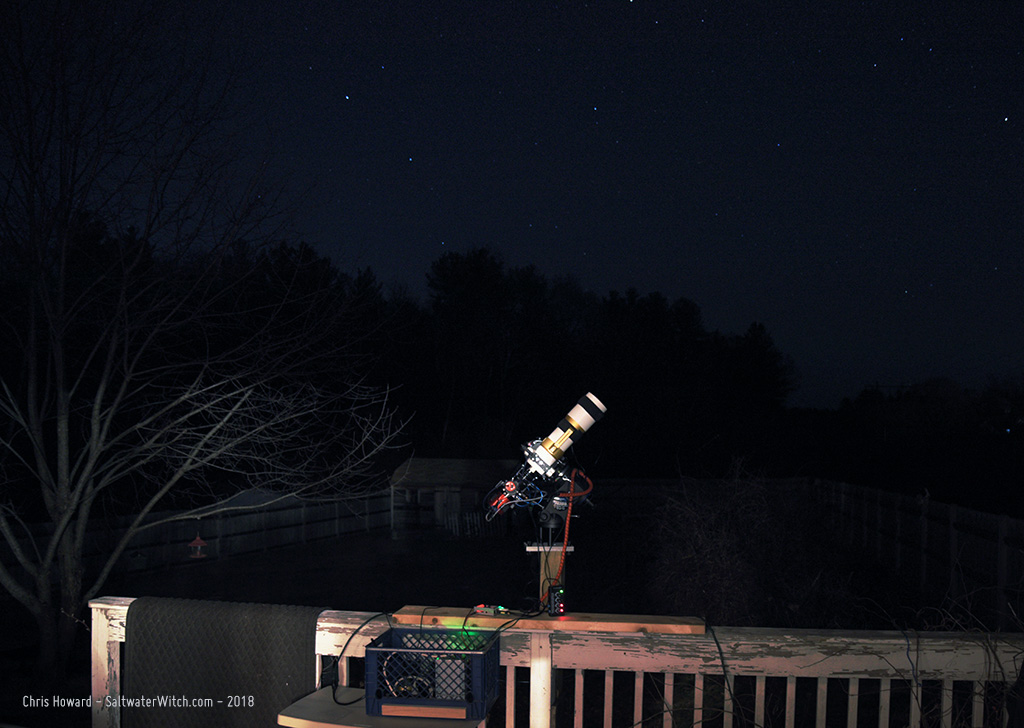
Posted December 11, 2018
December Comets
I didn't just take some shots of comet 46P/Wirtanen last night. I also captured comet 14P/Wolf as it passed by the blue giant star, Rigel (the lower right star in Orion). I posted some time lapse shots of both on youtube.
Posted December 9, 2018
Comet 46P/Wirtanen
I caught Comet 46P/Wirtanen in one 240-second exposure as it was passing through the constellation Eridanus. Next week 46P will pass about 7.2 million miles (0.0774 AU) from Earth, it's closest approach for the next 20 years. William Optics GT81, ZWO ASI071MC camera, Orion Atlas EQ-G
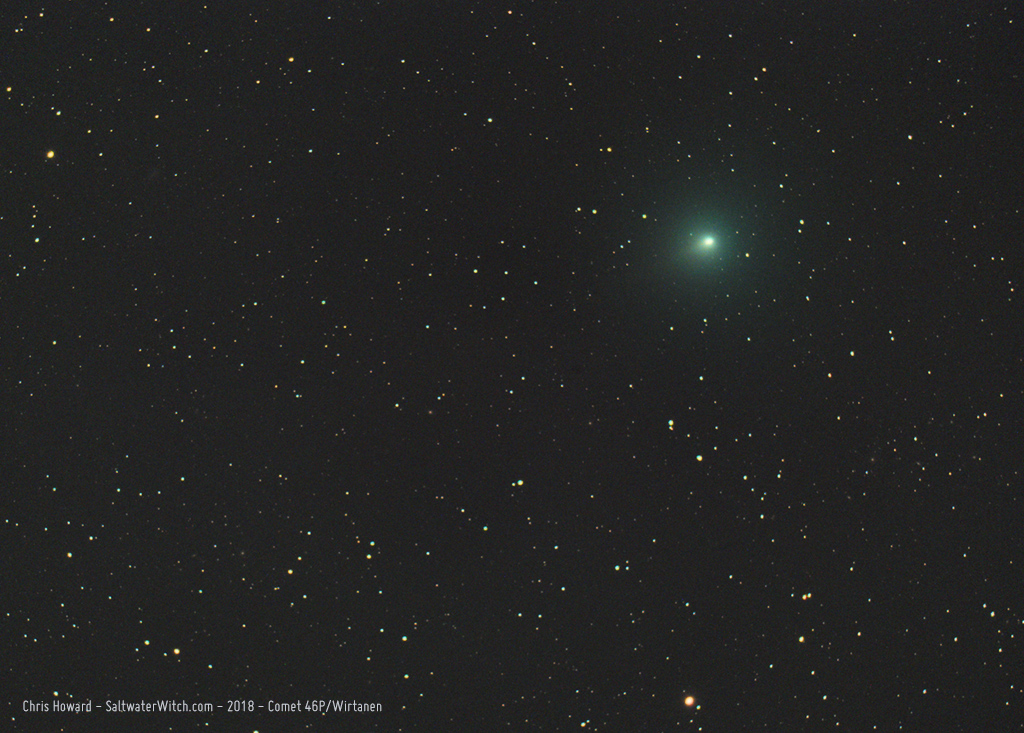
Posted December 9, 2018
Astro Session - November 10, 2018
Soulful Friday--more importantly it was a cloudless Friday on the 10th. I'm going to have to do a mosaic for the whole thing, but for now here's the southern end of IC 1848, the "Soul Nebula" in Ha and OIII (Soul is also identified as Westerhout 5 and Sh 2-199). IC 1848 is in the constellation Cassiopeia, and what you see here is a bit more than half the 100 lightyears in length of the whole nebula--so what is that, something like 588 quadrillion miles from top to bottom? At 6,500 light-years away, that will make a nice four panel mosaic. (Notes: 40 x 240 seconds in Ha, 28 x 600 sec. in OIII. Atik 414EX mono CCD, Astronomik 12nm Ha, OIII filters, William Optics ZS61 + WO Flat F6A f/4.7, iOptron CEM25P EQ mount, Orion OAG + ZWO ASI120MM-Mini guide cam, Stellarmate OS (INDI/KStars/Ekos) running on Raspberry Pi 3b+)
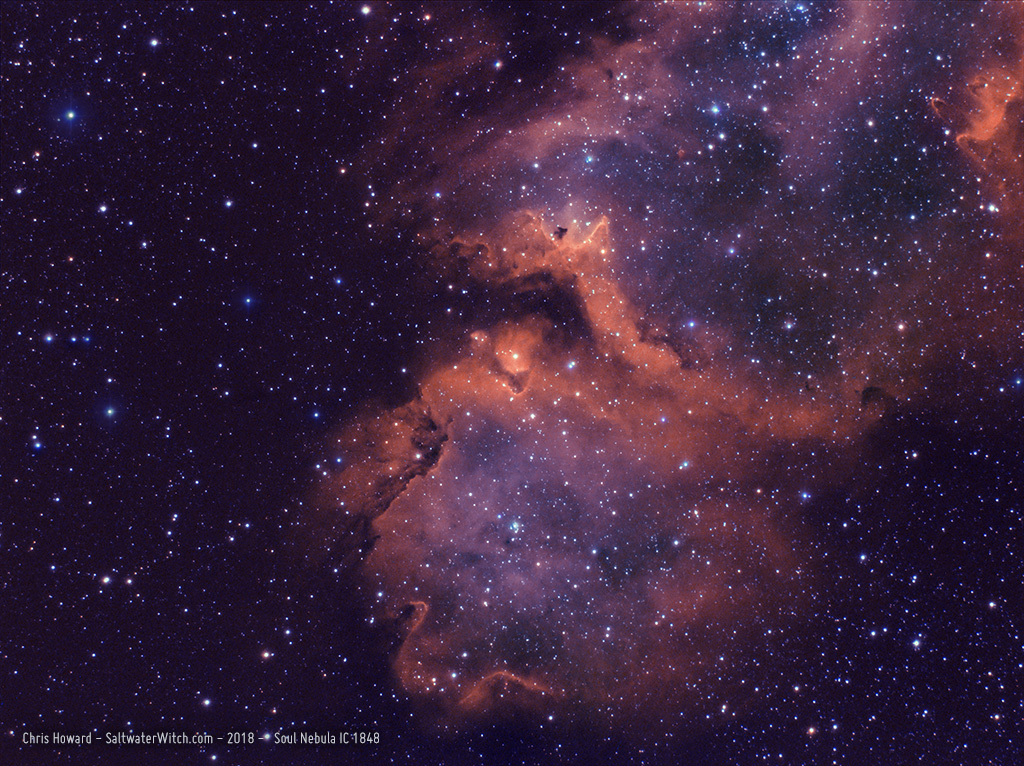
This is the first time I've captured any subs of NGC 2264, the Cone Nebula, about 2600 light-years away (800 Parsecs) in the constellation Monoceros. NGC 2264 includes several identified objects, including the Cone Nebula, Fox Fur Nebula and a massive variable star system, the Christmas Tree Cluster at its core. (Notes: 61 x 300 seconds in Ha, 48 x 300 sec. in OIII. Atik 414EX mono CCD, Astronomik 12nm Ha, OIII filters, William Optics ZS61 + WO Flat F6A f/4.7, CEM25P EQ mount, Orion OAG + ZWO ASI120MM-Mini guide cam, Stellarmate OS (INDI/KStars/Ekos) running on Raspberry Pi 3b+)
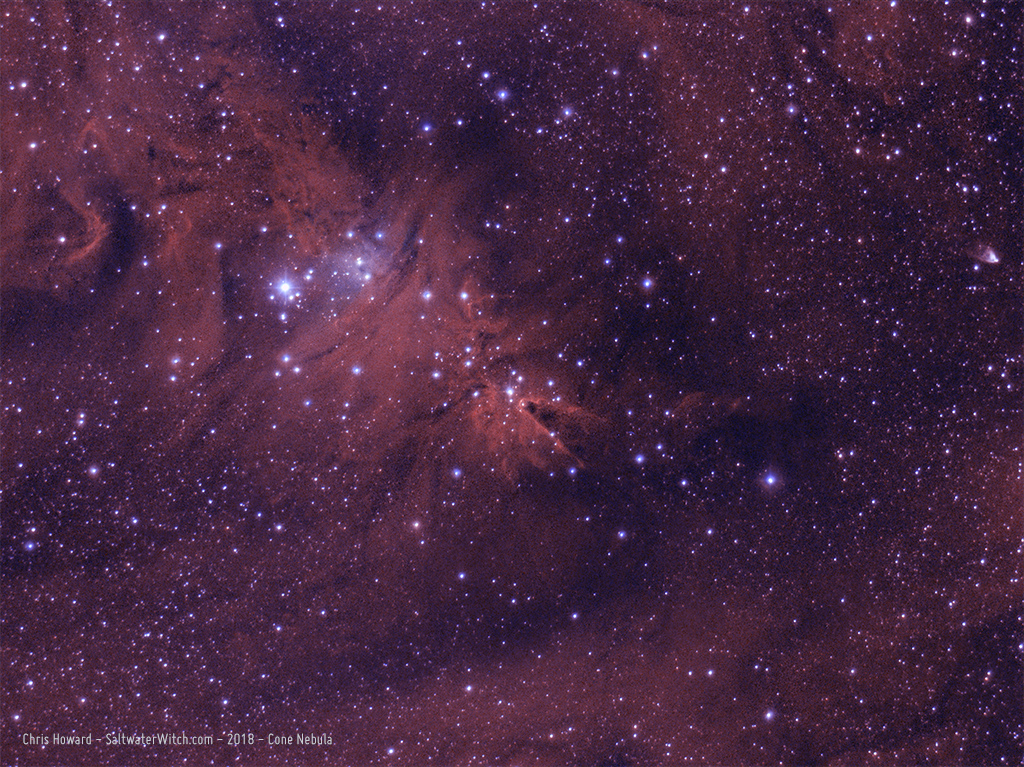
Near-Infrared: I also captured 40 frames of M78, a reflection nebula in the constellation Orion. I captured 20 of each in Ha (~656nm) and infrared with the 685nm longpass filter to see what showed up, and was surprised by what I could see in the unstretched subs. There really is a lot going on at the red end of the spectrum--and beyond, and I combined both of them in this shot, divided evenly across RGB (R=Ha, G=50%Ha/50%IR, B=IR). The plan is to come back with a set of color frames and see if I can combine the whole set.
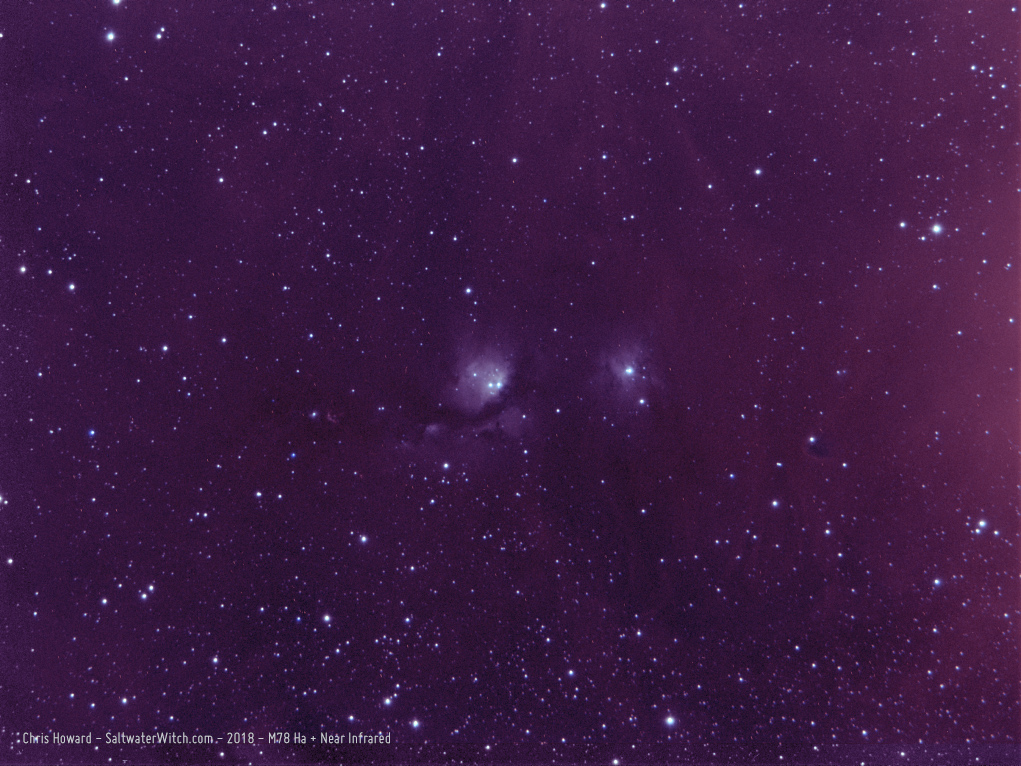
I took some pics of my narrowband setup for this imaging run, before nightfall and in the middle of shooting frames for the Cone Nebula just before Meridian Flip.
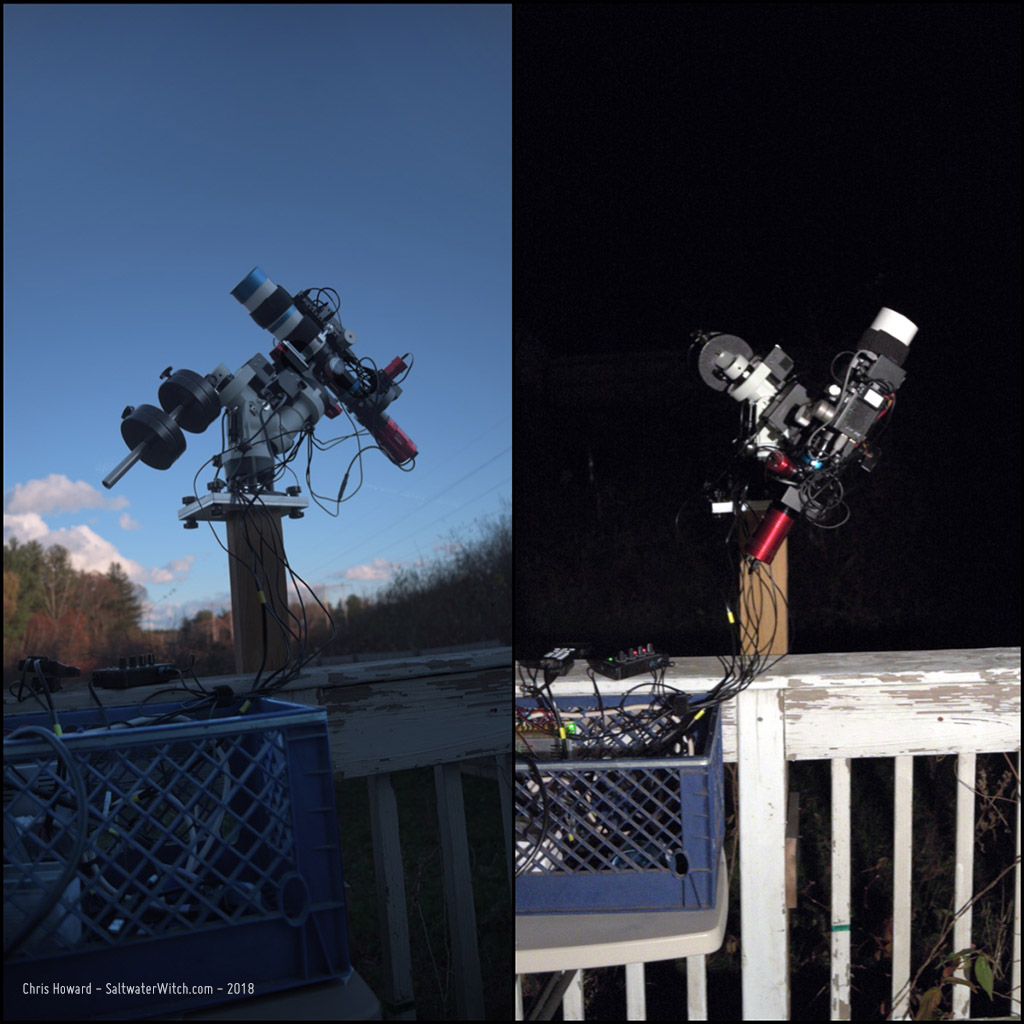
Here's a screenshot of Ekos and KStars running, with the guiding tab opened. It was pretty windy, so an RMS" of 0.58 is great, but overall my guiding has improved since going to an Off-Axis Guider. I'm now using the Orion Thin OAG on both trains--color and narrowband, and the difference is noticeable. It took some time to dial sensor and focus distances in, but results are clear, and I just don't think I'll ever go back to a guide scope.
